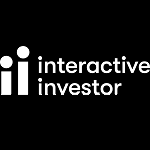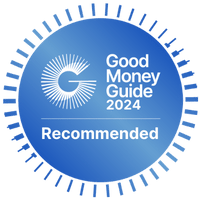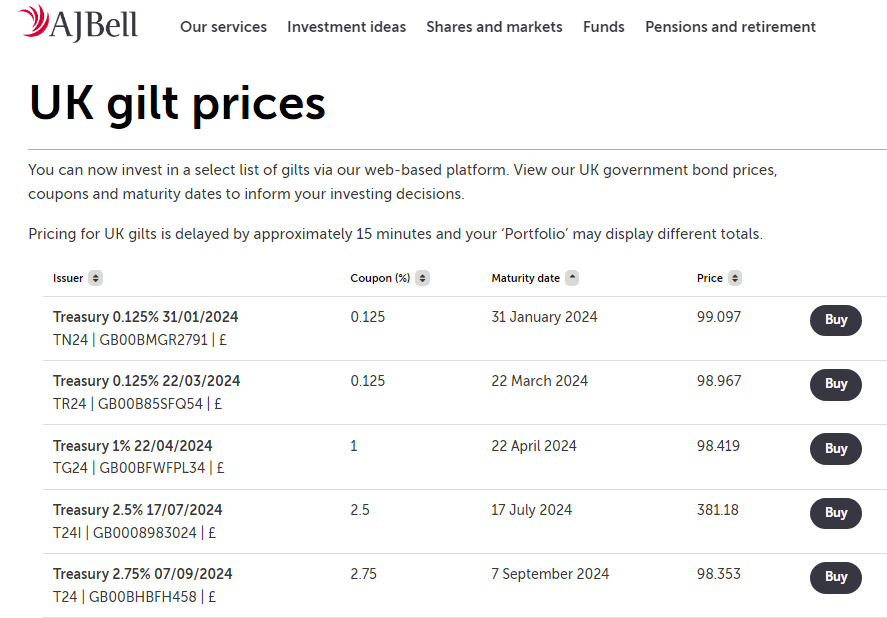| Name | Logo | GMG Rating | Customer Reviews | Gilt Annual Fees | Gilt Dealing Commission | CTA | Feature | Expand |
|---|---|---|---|---|---|---|---|---|
|
GMG Rating |
Customer Reviews 4.3
(Based on 1,120 reviews)
|
Gilt Annual Fees £59.88 |
Gilt Dealing Commission £3.99 |
See Gilts Capital at risk
interactive investor Reviews |
Features:
|
Interactive Investor charges a low flat monthly fee for all their investing accounts.
interactive investor offers fixed fee investing on a wide range of investments Provider: Interactive Investor Verdict: Interactive Investor’s fixed fee account structure make them one of the most cost effective ways for people with large portfolios to manage their investments, ISAs and pensions. ii are expecially good for high value portfolios and those wanting access to small cap stocks. What does interactive investor do? Interactive Investor or II as its known is one of the UK’s largest self-determined investor platforms. II can trace its roots back to 1995 and the startup floated on the London stock exchange back in the year 2000 before being bought by the Australian business Ample in 2002. Today, Interactive Investor is a owned by abrdn with assets under administration of more than £50 billion and 400,000 customers to whom II offers share trading and investment services including, ISAs SIPPs and share dealing, alongside research and analysis. Including model portfolios, selected funds and thematic investments. Interactive Investor differs from other investment platforms as it charges a fixed account fee, rather than a percentage of the funds you have on account. Which, over time, could save you thousands in costs. As a low-cost provider ii competes directly with the likes of Hargreaves Lansdown and AJ Bell offering general investment accounts, ISAs and pensions. Pricing: Brilliant for medium and large investors, expensive for small accounts. Does interactive investor pay interest on cash? Yes, but only 2% for under £10k and you need at least £100k in your account to get their best rate of 3.25%. There are other brokers that offer better rates on uninvested cash, though. interactive investor versus Interactive Brokers interactive broker and interactive investor may sound similar but cater to different investor profiles and operate under different jurisdictions and cater for different types of investors. interactive brokers is a US‑based global brokerage offering a wide spectrum of asset classes and advanced trading tools, often targeting active traders and professionals. interactive investor, by contrast, is a UK‑focused subscription‑based platform offering a fixed‑fee structure suited to medium‑to‑long‑term investors primarily in equities, funds, bonds, Gilts, ISAs, and SIPPs. interactive investor employs simpler platforms with relatively basic charting tools, while interactive brokers features a more complex interface and lower per-trade costs but with more variable fees. interactive investor is better for large longer term investment accounts because of its simplicity, flat monthly fee and broad UK offerings, whereas Interactive Brokers suits users seeking global market access and sophisticated execution tools. Can you buy Gilts on interactive investor? Yes, ii supports investment in government bonds, including UK Gilts, via its platform. This is confirmed on the site, which lists bonds and Gilts as available investments . Pros
Cons
Overall5 Interactive Investor’s website will also show you a small list of gilts available to trade on the platform.
Interactive Investor’s website will also show you a small list of gilts available to trade on the platform.
 |
||
|
GMG Rating |
Customer Reviews 4.2
(Based on 1,094 reviews)
|
Gilt Annual Fees 0% – 0.25% |
Gilt Dealing Commission £3.50 – £5 |
See Gilts Capital at risk
AJ Bell Reviews |
Features:
|
AJ Bell is a well-established low-cost investment platform for buying Gilts.
AJ Bell Review: A low cost full service investing platform Provider: AJ Bell Verdict: AJ Bell is an award-winning, low-cost online investing platform for UK DIY investors. Founded in 1995, AJ Bell has grown to become one of the UK’s leading investment platforms. Today, it has more than 440,000 customers and assets under administration (AUA) of over £150 billion. Is AJ Bell good for investing? AJ Bell is an excellent full-service stock broker that offers a wide range of services for investors, including share dealing, fund investing, cash-saving services, and mobile dealing. It also offers a range of accounts including Stocks and Shares ISAs, Lifetime ISAs, Self-Invested Personal Pensions (SIPPs), dealing accounts, and investment accounts for children. Pros
Cons
Overall4.8 |
||
|
GMG Rating |
Customer Reviews 3.8
(Based on 1,762 reviews)
|
Gilt Annual Fees 0% – 0.45% |
Gilt Dealing Commission £5.95 – £11.95 |
See Gilts Capital at risk
Hargreaves Lansdown Reviews |
Features:
|
Hargreaves Lansdown has an excellent free-to-view market data portal where you can view bond and gilt prices. In January 2025 HL saw the highest number of gilt purchases in four years.
Hargreaves Lansdown Review: The Waitrose of the investing world Provider: Hargreaves Lansdown Verdict: Founded in 1981 Hargreaves Lansdown is one of the largest investment platforms in the UK. They offer investing, savings, ISAs and SIPP account to over 1.8 million clients with 142bn in assets under management. Is Hargreaves Lansdown a good broker? Yes, Hargreaves Lansdown is one of our best-rated stock brokers and investment platforms. HL offers access to a huge range of investment types, through a wide range of general and tax-efficient accounts and is suitable for almost all types of investors. I always think of Hargreaves Lansdown as the Waitrose of the investing world. Yes, it may be a bit pricier sometimes, but I think it’s just a nicer, safer place to shop for stocks. Pros
Cons
Overall4.9 |
❓Methodology: Our experts chose what we think are the best investment accounts for buying gilts based on:
- Over 30,000 votes and reviews in the coveted Good Money Guide annual awards
- Our own experiences testing the gilt investment accounts with real money
- An in-depth comparison of the features that make them stand out compared to alternative investing platforms for buying gilts
- Our exclusive interviews with the gilt investment account company CEOs and senior management
How To Buy UK Government Gilts
You can buy UK Government bonds either directly from the DMO or through various bond brokers (see here for US ones) and investment platforms.
Basic Requirements:
Specific Requirements:
Steps to buying gilts




Buying Gilts at Auction
In February 2024, Hargreaves Lansdown and Interactive Investor two of Britain’s largest stockbrokers, and direct-to-consumer investing platforms, opened up the UK Gilt-edged or government bond market to retail traders and savers.
HL & II are partnered with one of the UK’s largest domestic market makers, Winterflood Securities, to offer retail traders and investors access to DMO auctions for the first time.
How does the process of buying Gilts at auction work?
Hargreaves Lansdown and Interactive Investors are now accepting orders from clients for the forthcoming issue of Treasury bonds.
Crucially they will not pay any commission or dealing fees on their order, unlike trading Gilts in the secondary market.
Retail investors will only be able to participate in auctions for new issues and not so-called Taps, which are additional issues of bonds already in the market, however, that may change in future.
Gilts can be held tax-free within both ISAs and SIPPs, something that’s likely to appeal to long-term retail investors and savers.
Tim Jacobs, head of primary markets at Hargreaves Lansdown said:
“We think there will be significant demand (and) It’s another example of retail investors being taken seriously- they are finally getting a seat at the table.”
Whilst Sir Robert Stheeman, the CEO of the UK DMO said:
“We value the importance of having as diverse an investor base as possible and this initiative will provide retail investors with an additional opportunity to access gilts.”
Gilts issued through the auction process can often come at a small discount to comparable existing issues in the secondary market.
A benefit that until now has been exclusive to banks, brokers and their institutional clients.
The new initiative comes at a time when government bond issuance is on the up and brings the country into line with peers in Europe and North America.
- Related guide: Are UK Government Bonds (Gilts) A Good Investment?
What are Gilt auctions?
Gilts are effectively government-backed IOUs.
Via Gilt issuance the UK government borrows money from the financial markets, paying an annual rate of interest for the duration of the loan.
Repaying the principal, to the lenders, on the maturity of that loan.
New issues of Gilts are bought to market by the DMO under an auction system, in which investors bid for the bonds at a particular yield or interest rate.
The pricing of those bids will depend on a variety of factors including:
- Underlying interest rates and swap market spreads
- The supply and demand of Gilts, both those in issue and those in the pipeline
- Sentiment among investors in the fixed-income markets
Alternative ways to buy Gilts:
If you are only interested in speculating on the price of gilts, then Saxo or IBKR offer Gilt derivatives.
- Saxo – Saxo is for advanced and professional investing. Bond dealing commission: 0.2% to 0.05%. You can only trade Gilt, futures or ETFs on Saxo Trader GO.
- Interactive Brokers – You can’t trade individual UK gilts on the IBKR portal, but you can buy Gilt ETFs, which give you access to a range of Gilts.
Alternatively, you can also buy and sell leveraged gilt funds. For example, the Wisdomtree Leverage 3x 10-year Gilt ETF (3GIL) is a high-octane vehicle for traders. The fund moves three times the daily movement of the Long Gilt Rolling Future Index. For obvious reasons, this ETF is not really suitable for every trader, especially investors with conservative financial objectives.
- Expert analysis: Are gilts a good investment?
Important factors to consider when buying gilts
When we talk about buying government bonds like gilts, we focus on a few important factors, like:
- Current yields – how much is the bond offering investors now?
- Maturity – how many more years do the debt instrument last?
- Credit ratings of the borrowing entity – is the organisation financially viable and has the means (taxes) to repay the debt?
As you can see above, gilts of different maturities offer different yields.
Assuming the credit rating of the UK government remains strong for the time being, which it is (see below), the two important factors are yield and maturity. How long do you intend to hold the debt for? Is the yield compensating investors sufficiently for the risk?

Source: worldgovernmentbonds.com
Recent data from bond brokers like Interactive Investor show that investors are picking up the near-term gilts (those maturing within 24 months). Yields are high; holding period short. A good parking place for surplus capital.
More crucially, in this volatile market there are two additional factors to consider:
- Trend of interest rates – Will interest rates drop further in the coming months? If yes, it tends to buoy gilt prices.
- Real interest rates – Will nominal rates compensate investors enough for the still-positive inflation?
Inflation this year (2024) has fallen to about 2 percent (1.7% in September ’24). This led to a couple of Bank of England rate cuts (latest 25bps cut in November) to match the fall in inflation. Wide volatility in economic trends are causing huge changes in financial markets. Against this backdrop the central bank is cautious not to cut too aggressively in case inflation rebounds.
Gilt ETFs for your portfolio
Average investors need to diversify. In doing so, it reduces the overall portfolio risk. Asset diversification balances the risk.
With near-term gilt yields (3-6 months) now at 4-5 percent, interest in the sector is high. However, instead of buying individual gilts, a portfolio of gilts may be more appropriate for some investors.
For example, the iShares 0-5 year Gilt (IGLS) is an exchange-traded fund (ETF) that holds a portfolio of gilts with maturities ranging from 0 to five years. According to its factsheet, more than two-fifth of IGLS’s £3.1 billion gilt portfolio matures within 24 months. A bond ETF, like many equity ETFs, may track a bond index. Here IGLS tracks the “FTSE UK Conventional Gilts – Up To 5 Years Index“.
From a high of 135, the ETF plunged to 122 due to the surging interest rates before staging a recovery rally. Recent price action has flatlined due to a modest rise in interest rates. Right now, the ETF’s yield-to-maturity fetches about 4 percent.
Another ETF that may interest readers is the iShares Gilt ETF (IGLT). This £3.1 billion bond fund (factsheet here) follows the “FTSE Actuaries UK Conventional Gilts All Stocks Index (link)”.

There is another sector that may be worth a look – index linked gilts. These bonds are linked to the price index Retail Price Index (PRI). Coupons and principal of the bonds are adjusted according to a set formula using the RPI index. These adjustments help to offset the erosion of buying power of capital. You can find out more about index linked gilts from the Debt Management Office (DMO).
There is a bond ETF that holds just indexed linked gilts. This is the £718 million iShares index-linked Gilt ETF (INXG, factsheet here). Due to the long-maturity of its gilt holdings (one-third in 20+ year maturity), the bond fund is particularly volatile. In 2022, the ETF’s total return was a shocking -34 percent. In the US, the equivalent is the TIPS Bond ETF (TIP).
How do government gilts work?
Gilts are government bonds, which is a financial instrument with a promise – a promise to pay certain sums periodically (‘interest’) and the original capital in the future. In this case, the debtor is the UK government.
It works like this. The UK government borrows money from the market to spend; it then raises revenue from the economy via taxes; and uses the tax revenue to repay interest and capital to the creditors.
Sometimes, the government will use new borrowings to retire old borrowings when it is cheaper to do so. The most recent statistics (April 2024, data published annually) show the total UK debt borrowings at the end of 2023 to be £2.7 trillion. As a percentage of UK’s GDP, this ratio is about 101 percent (see below, recent report). Fiscally-prudent investors will think this is too high. Germany, they point out, has the debt-to-GDP ratio of about 64 percent. But as long as the market thinks the UK government has the ability to re-finance these debt instruments, there is no reason to panic.

Source: ONS (Apr 2024, annual figures)
How safe are government gilts?
Not all sovereign debtors are equal. What differentiates sovereign bonds are the rate of interest, collateral, duration, debt levels, and the credibility of borrowers.
Another important point is the absence of military conflicts in that region, since conflicts will disrupt trade, investments and capital flows.
Creditors certainly want to borrow from sovereign governments that can repay. This ability to repay is measured crudely by sovereign credit ratings. Third-party professional firms called rating agencies (Standard & Poor’s, Fitch, and Moody’s) assigned these ratings to nearly all governments that issue bonds. The UK has enjoyed good ratings in recent years. The chart below compares the S&P sovereign ratings across the world. The UK is currently double A investment grade (2024).
In September 2024, Fitch reaffirmed UK’s sovereign ratings at AA-.

Source: S&P/Wikipedia (March 2024) – click link and see individual rating changes
What is the relationship between gilt yields and price?
The relationship between bond yield and price is simple: They move in the opposite direction. Look at the chart below. Here I use a US bond ETF (IEF) as an example.
As US bond prices dropped (blue line), the 10-year bond yield rose (orange line). In other words, the higher the bond yield, the lower the price.
Generally speaking, shorter-maturity government bond yields (maturities of less than two years) track the central bank policy rate closely.
This means that as central bank raises the policy rate, these 0-2 year yields rise too – and vice versa. Longer maturity bonds, however, may not track the policy rate that closely for a variety of reasons, including inflation expectations.
- Further reading: You can read more about how bonds work here in our bond guide.


Richard is the founder of the Good Money Guide (formerly Good Broker Guide), one of the original investment comparison sites established in 2015. With a career spanning two decades as a broker, he brings extensive expertise and knowledge to the financial landscape.
Having worked as a broker at Investors Intelligence and a multi-asset derivatives broker at MF Global (Man Financial), Richard has acquired substantial experience in the industry. His career began as a private client stockbroker at Walker Crips and Phillip Securities (now King and Shaxson), following internships on the NYMEX oil trading floor in New York and London IPE in 2001 and 2000.
Richard’s contributions and expertise have been recognized by respected publications such as The Sunday Times, BusinessInsider, Yahoo Finance, BusinessNews.org.uk, Master Investor, Wealth Briefing, iNews, and The FT, among many others.
Under Richard’s leadership, the Good Money Guide has evolved into a valuable destination for comprehensive information and expert guidance, specialising in trading, investment, and currency exchange. His commitment to delivering high-quality insights has solidified the Good Money Guide’s standing as a well-respected resource for both customers and industry colleagues.
To contact Richard, please ask a question in our financial discussion forum.




